Lingyi Hong
Fudan university
LingoLoop Attack: Trapping MLLMs via Linguistic Context and State Entrapment into Endless Loops
Jun 17, 2025Abstract:Multimodal Large Language Models (MLLMs) have shown great promise but require substantial computational resources during inference. Attackers can exploit this by inducing excessive output, leading to resource exhaustion and service degradation. Prior energy-latency attacks aim to increase generation time by broadly shifting the output token distribution away from the EOS token, but they neglect the influence of token-level Part-of-Speech (POS) characteristics on EOS and sentence-level structural patterns on output counts, limiting their efficacy. To address this, we propose LingoLoop, an attack designed to induce MLLMs to generate excessively verbose and repetitive sequences. First, we find that the POS tag of a token strongly affects the likelihood of generating an EOS token. Based on this insight, we propose a POS-Aware Delay Mechanism to postpone EOS token generation by adjusting attention weights guided by POS information. Second, we identify that constraining output diversity to induce repetitive loops is effective for sustained generation. We introduce a Generative Path Pruning Mechanism that limits the magnitude of hidden states, encouraging the model to produce persistent loops. Extensive experiments demonstrate LingoLoop can increase generated tokens by up to 30 times and energy consumption by a comparable factor on models like Qwen2.5-VL-3B, consistently driving MLLMs towards their maximum generation limits. These findings expose significant MLLMs' vulnerabilities, posing challenges for their reliable deployment. The code will be released publicly following the paper's acceptance.
CrossLMM: Decoupling Long Video Sequences from LMMs via Dual Cross-Attention Mechanisms
May 22, 2025Abstract:The advent of Large Multimodal Models (LMMs) has significantly enhanced Large Language Models (LLMs) to process and interpret diverse data modalities (e.g., image and video). However, as input complexity increases, particularly with long video sequences, the number of required tokens has grown significantly, leading to quadratically computational costs. This has made the efficient compression of video tokens in LMMs, while maintaining performance integrity, a pressing research challenge. In this paper, we introduce CrossLMM, decoupling long video sequences from LMMs via a dual cross-attention mechanism, which substantially reduces visual token quantity with minimal performance degradation. Specifically, we first implement a significant token reduction from pretrained visual encoders through a pooling methodology. Then, within LLM layers, we employ a visual-to-visual cross-attention mechanism, wherein the pooled visual tokens function as queries against the original visual token set. This module enables more efficient token utilization while retaining fine-grained informational fidelity. In addition, we introduce a text-to-visual cross-attention mechanism, for which the text tokens are enhanced through interaction with the original visual tokens, enriching the visual comprehension of the text tokens. Comprehensive empirical evaluation demonstrates that our approach achieves comparable or superior performance across diverse video-based LMM benchmarks, despite utilizing substantially fewer computational resources.
NTIRE 2025 Challenge on Cross-Domain Few-Shot Object Detection: Methods and Results
Apr 14, 2025Abstract:Cross-Domain Few-Shot Object Detection (CD-FSOD) poses significant challenges to existing object detection and few-shot detection models when applied across domains. In conjunction with NTIRE 2025, we organized the 1st CD-FSOD Challenge, aiming to advance the performance of current object detectors on entirely novel target domains with only limited labeled data. The challenge attracted 152 registered participants, received submissions from 42 teams, and concluded with 13 teams making valid final submissions. Participants approached the task from diverse perspectives, proposing novel models that achieved new state-of-the-art (SOTA) results under both open-source and closed-source settings. In this report, we present an overview of the 1st NTIRE 2025 CD-FSOD Challenge, highlighting the proposed solutions and summarizing the results submitted by the participants.
MSVCOD:A Large-Scale Multi-Scene Dataset for Video Camouflage Object Detection
Feb 19, 2025


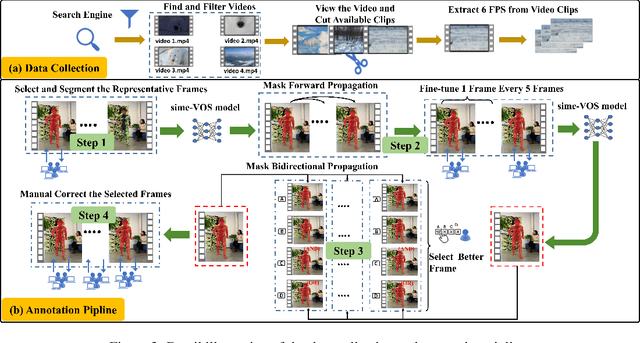
Abstract:Video Camouflaged Object Detection (VCOD) is a challenging task which aims to identify objects that seamlessly concealed within the background in videos. The dynamic properties of video enable detection of camouflaged objects through motion cues or varied perspectives. Previous VCOD datasets primarily contain animal objects, limiting the scope of research to wildlife scenarios. However, the applications of VCOD extend beyond wildlife and have significant implications in security, art, and medical fields. Addressing this problem, we construct a new large-scale multi-domain VCOD dataset MSVCOD. To achieve high-quality annotations, we design a semi-automatic iterative annotation pipeline that reduces costs while maintaining annotation accuracy. Our MSVCOD is the largest VCOD dataset to date, introducing multiple object categories including human, animal, medical, and vehicle objects for the first time, while also expanding background diversity across various environments. This expanded scope increases the practical applicability of the VCOD task in camouflaged object detection. Alongside this dataset, we introduce a one-steam video camouflage object detection model that performs both feature extraction and information fusion without additional motion feature fusion modules. Our framework achieves state-of-the-art results on the existing VCOD animal dataset and the proposed MSVCOD. The dataset and code will be made publicly available.
VideoPure: Diffusion-based Adversarial Purification for Video Recognition
Jan 25, 2025



Abstract:Recent work indicates that video recognition models are vulnerable to adversarial examples, posing a serious security risk to downstream applications. However, current research has primarily focused on adversarial attacks, with limited work exploring defense mechanisms. Furthermore, due to the spatial-temporal complexity of videos, existing video defense methods face issues of high cost, overfitting, and limited defense performance. Recently, diffusion-based adversarial purification methods have achieved robust defense performance in the image domain. However, due to the additional temporal dimension in videos, directly applying these diffusion-based adversarial purification methods to the video domain suffers performance and efficiency degradation. To achieve an efficient and effective video adversarial defense method, we propose the first diffusion-based video purification framework to improve video recognition models' adversarial robustness: VideoPure. Given an adversarial example, we first employ temporal DDIM inversion to transform the input distribution into a temporally consistent and trajectory-defined distribution, covering adversarial noise while preserving more video structure. Then, during DDIM denoising, we leverage intermediate results at each denoising step and conduct guided spatial-temporal optimization, removing adversarial noise while maintaining temporal consistency. Finally, we input the list of optimized intermediate results into the video recognition model for multi-step voting to obtain the predicted class. We investigate the defense performance of our method against black-box, gray-box, and adaptive attacks on benchmark datasets and models. Compared with other adversarial purification methods, our method overall demonstrates better defense performance against different attacks. Our code is available at https://github.com/deep-kaixun/VideoPure.
DeTrack: In-model Latent Denoising Learning for Visual Object Tracking
Jan 05, 2025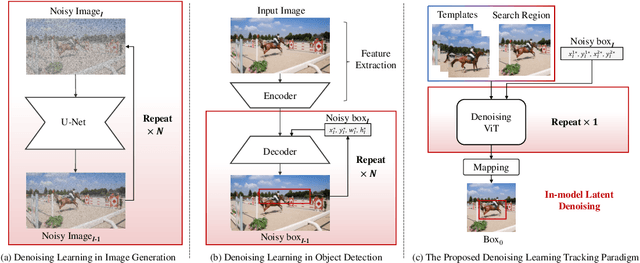

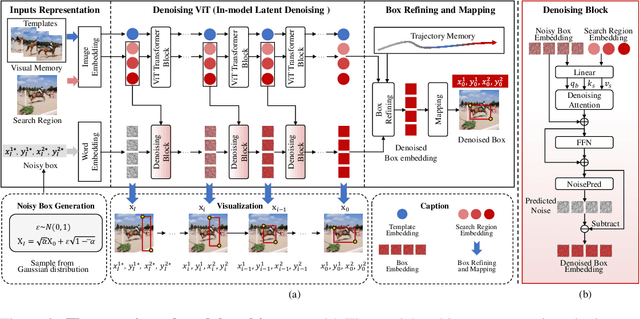
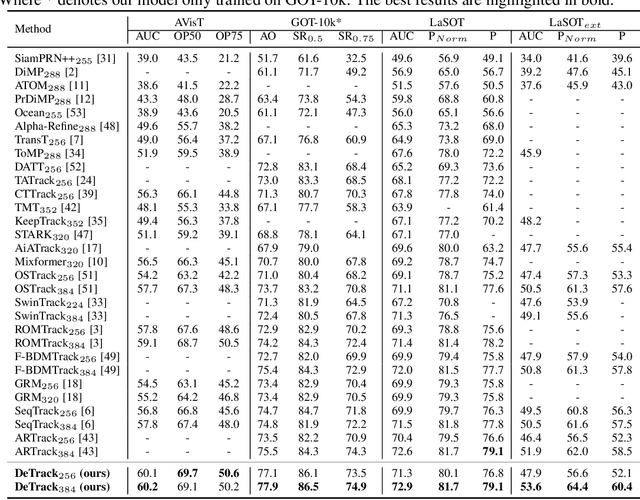
Abstract:Previous visual object tracking methods employ image-feature regression models or coordinate autoregression models for bounding box prediction. Image-feature regression methods heavily depend on matching results and do not utilize positional prior, while the autoregressive approach can only be trained using bounding boxes available in the training set, potentially resulting in suboptimal performance during testing with unseen data. Inspired by the diffusion model, denoising learning enhances the model's robustness to unseen data. Therefore, We introduce noise to bounding boxes, generating noisy boxes for training, thus enhancing model robustness on testing data. We propose a new paradigm to formulate the visual object tracking problem as a denoising learning process. However, tracking algorithms are usually asked to run in real-time, directly applying the diffusion model to object tracking would severely impair tracking speed. Therefore, we decompose the denoising learning process into every denoising block within a model, not by running the model multiple times, and thus we summarize the proposed paradigm as an in-model latent denoising learning process. Specifically, we propose a denoising Vision Transformer (ViT), which is composed of multiple denoising blocks. In the denoising block, template and search embeddings are projected into every denoising block as conditions. A denoising block is responsible for removing the noise in a predicted bounding box, and multiple stacked denoising blocks cooperate to accomplish the whole denoising process. Subsequently, we utilize image features and trajectory information to refine the denoised bounding box. Besides, we also utilize trajectory memory and visual memory to improve tracking stability. Experimental results validate the effectiveness of our approach, achieving competitive performance on several challenging datasets.
P3S-Diffusion:A Selective Subject-driven Generation Framework via Point Supervision
Dec 27, 2024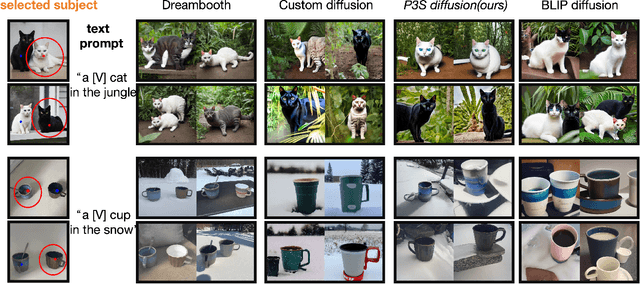
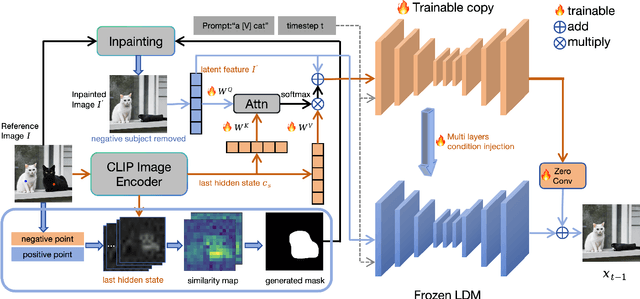
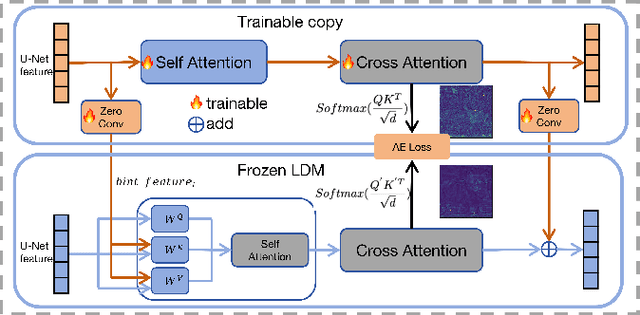
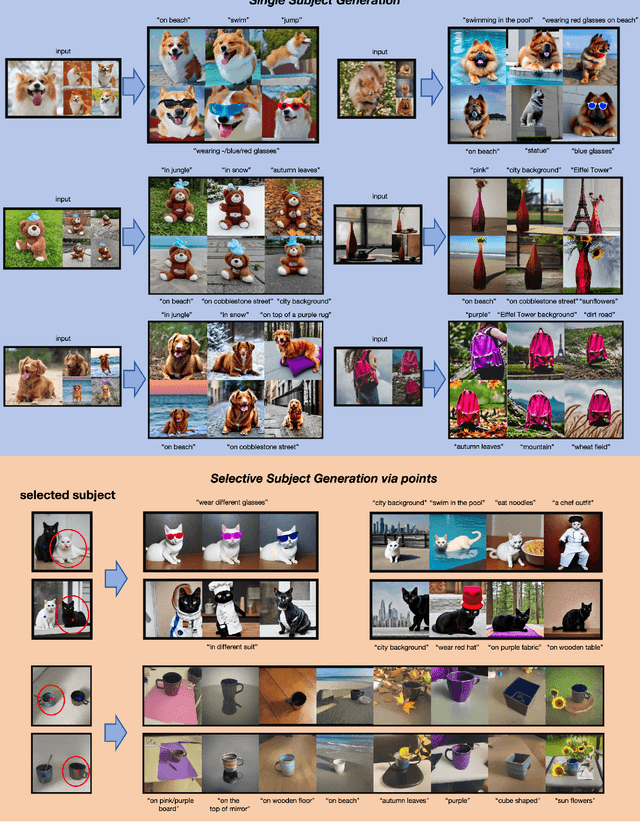
Abstract:Recent research in subject-driven generation increasingly emphasizes the importance of selective subject features. Nevertheless, accurately selecting the content in a given reference image still poses challenges, especially when selecting the similar subjects in an image (e.g., two different dogs). Some methods attempt to use text prompts or pixel masks to isolate specific elements. However, text prompts often fall short in precisely describing specific content, and pixel masks are often expensive. To address this, we introduce P3S-Diffusion, a novel architecture designed for context-selected subject-driven generation via point supervision. P3S-Diffusion leverages minimal cost label (e.g., points) to generate subject-driven images. During fine-tuning, it can generate an expanded base mask from these points, obviating the need for additional segmentation models. The mask is employed for inpainting and aligning with subject representation. The P3S-Diffusion preserves fine features of the subjects through Multi-layers Condition Injection. Enhanced by the Attention Consistency Loss for improved training, extensive experiments demonstrate its excellent feature preservation and image generation capabilities.
X-Prompt: Multi-modal Visual Prompt for Video Object Segmentation
Sep 28, 2024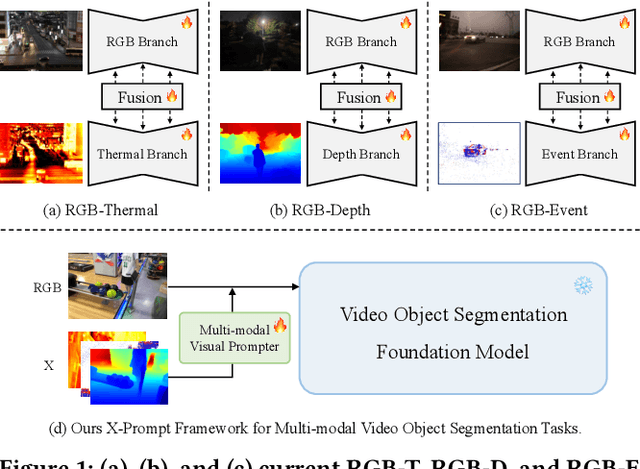
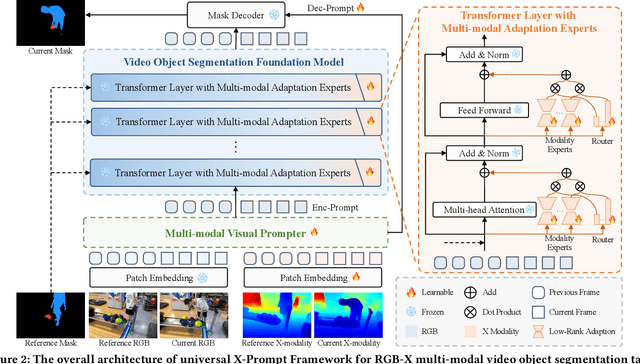
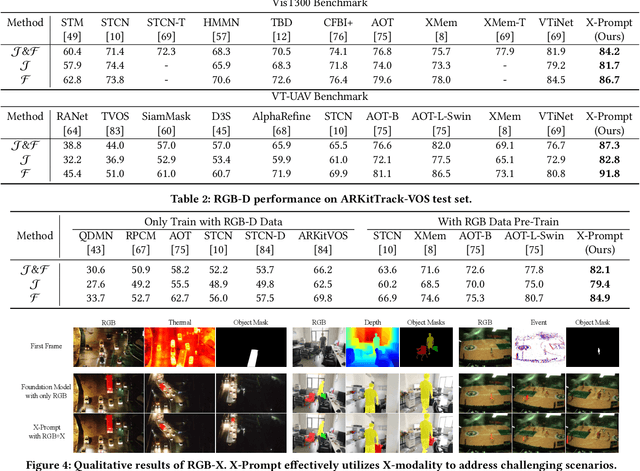

Abstract:Multi-modal Video Object Segmentation (VOS), including RGB-Thermal, RGB-Depth, and RGB-Event, has garnered attention due to its capability to address challenging scenarios where traditional VOS methods struggle, such as extreme illumination, rapid motion, and background distraction. Existing approaches often involve designing specific additional branches and performing full-parameter fine-tuning for fusion in each task. However, this paradigm not only duplicates research efforts and hardware costs but also risks model collapse with the limited multi-modal annotated data. In this paper, we propose a universal framework named X-Prompt for all multi-modal video object segmentation tasks, designated as RGB+X. The X-Prompt framework first pre-trains a video object segmentation foundation model using RGB data, and then utilize the additional modality of the prompt to adapt it to downstream multi-modal tasks with limited data. Within the X-Prompt framework, we introduce the Multi-modal Visual Prompter (MVP), which allows prompting foundation model with the various modalities to segment objects precisely. We further propose the Multi-modal Adaptation Experts (MAEs) to adapt the foundation model with pluggable modality-specific knowledge without compromising the generalization capacity. To evaluate the effectiveness of the X-Prompt framework, we conduct extensive experiments on 3 tasks across 4 benchmarks. The proposed universal X-Prompt framework consistently outperforms the full fine-tuning paradigm and achieves state-of-the-art performance. Code: https://github.com/PinxueGuo/X-Prompt.git
General Compression Framework for Efficient Transformer Object Tracking
Sep 26, 2024



Abstract:Transformer-based trackers have established a dominant role in the field of visual object tracking. While these trackers exhibit promising performance, their deployment on resource-constrained devices remains challenging due to inefficiencies. To improve the inference efficiency and reduce the computation cost, prior approaches have aimed to either design lightweight trackers or distill knowledge from larger teacher models into more compact student trackers. However, these solutions often sacrifice accuracy for speed. Thus, we propose a general model compression framework for efficient transformer object tracking, named CompressTracker, to reduce the size of a pre-trained tracking model into a lightweight tracker with minimal performance degradation. Our approach features a novel stage division strategy that segments the transformer layers of the teacher model into distinct stages, enabling the student model to emulate each corresponding teacher stage more effectively. Additionally, we also design a unique replacement training technique that involves randomly substituting specific stages in the student model with those from the teacher model, as opposed to training the student model in isolation. Replacement training enhances the student model's ability to replicate the teacher model's behavior. To further forcing student model to emulate teacher model, we incorporate prediction guidance and stage-wise feature mimicking to provide additional supervision during the teacher model's compression process. Our framework CompressTracker is structurally agnostic, making it compatible with any transformer architecture. We conduct a series of experiment to verify the effectiveness and generalizability of CompressTracker. Our CompressTracker-4 with 4 transformer layers, which is compressed from OSTrack, retains about 96% performance on LaSOT (66.1% AUC) while achieves 2.17x speed up.
LSVOS Challenge Report: Large-scale Complex and Long Video Object Segmentation
Sep 09, 2024



Abstract:Despite the promising performance of current video segmentation models on existing benchmarks, these models still struggle with complex scenes. In this paper, we introduce the 6th Large-scale Video Object Segmentation (LSVOS) challenge in conjunction with ECCV 2024 workshop. This year's challenge includes two tasks: Video Object Segmentation (VOS) and Referring Video Object Segmentation (RVOS). In this year, we replace the classic YouTube-VOS and YouTube-RVOS benchmark with latest datasets MOSE, LVOS, and MeViS to assess VOS under more challenging complex environments. This year's challenge attracted 129 registered teams from more than 20 institutes across over 8 countries. This report include the challenge and dataset introduction, and the methods used by top 7 teams in two tracks. More details can be found in our homepage https://lsvos.github.io/.
 Add to Chrome
Add to Chrome Add to Firefox
Add to Firefox Add to Edge
Add to Edge